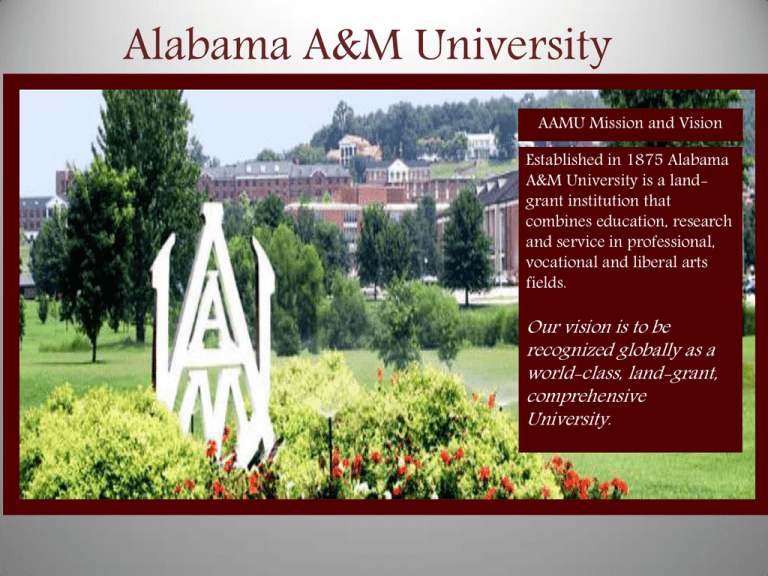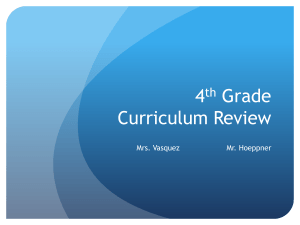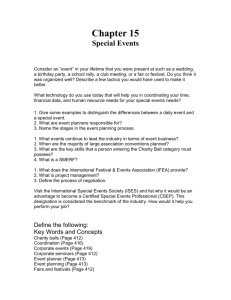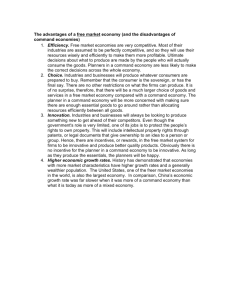Alabama A&M University
advertisement

Alabama A&M University AAMU Mission and Vision Established in 1875 Alabama A&M University is a landgrant institution that combines education, research and service in professional, vocational and liberal arts fields. Our vision is to be recognized globally as a world-class, land-grant, comprehensive University. Founder of AAMU William Hooper Councill, educator and race leader, was born into slavery in Fayetteville, North Carolina, on July 12, 1849. Founded in 1875 by a former slave, William Hooper Councill and opened as the “Huntsville Normal School” in downtown Huntsville. In 1875, the Alabama legislature appointed 26 year old Councill as the first principal of the State Colored Normal School at Huntsville, which is now known as Alabama A&M University. The school opened on May 1, 1875 with an appropriation of $1,000 in the basement of a Huntsville church. The Colored Normal School would train black teachers to work in Alabama's segregated school system. By the mid 1880s, it rivaled Tuskegee Institute in central Alabama as vocational-industrial training facility. Statute of William Hooper Councill at AAMU 1849-1909 On April 9, 1909, following a long illness, William Hooper Councill died in Huntsville at the age of 61. What is Planning? Planning, also called urban planning or city and regional planning, is a dynamic profession that works to improve the welfare of people and their communities by creating more convenient, equitable, healthful, efficient, and attractive places for present and future generations. Planning enables civic leaders, businesses, and citizens to play a meaningful role in creating communities that enrich people's lives. Good planning helps create communities that offer better choices for where and how people live. Planning helps communities to envision their future. It helps them find the right balance of new development and essential services, environmental protection, and innovative change. Whatdo do Planners Planners What What do PlannersDo? Do? Do? Professional help create create aa Professional planners planners help broad vision for for the the community. community. broad vision They also research, research, design, They also design, and and develop lead public public develop programs; programs; lead processes; processes; effect effectsocial social change; change; perform technical analyses; analyses; perform technical manage; educate. manage; and and educate. Some on just just some some Some planners planners focus focus on of of these these roles, roles,such such as as transportation but most most transportation planning, planning, but will workat atmany manykinds kindsofofplanning will work planning throughout their careers. throughout their careers. The basic element element is The basic is the the creation creation of aofplan. Planners develop a plan a plan. Planners develop a plan through analysis of of data data and and through analysis identification of goals goals for for the the identification of community or the the project. project. Planners community or Planners help the community and help the community and its various its various groups identify their groups identify their goals and goals form a vision. particular vision. form aand particular Types of Jobs Planners Do • Land Use Planning • Coordination of important community activities (housing, recreation, infrastructure, transportation, water quality, etc.) • Agriculture Land and Open Space Protection • Natural Resource Management • Developing and administering local and land developmental regulations • Evaluating of impact of different kinds of growth • Economic Development including business recruitment and retention • Urban Redevelopment • Water-front Development • Community and Neighborhood based planning • Growth Management • Transportation Planning Where do Planners Work? Planners work in every state and around the world. They work in rural areas, suburban areas, and large cities. They function in the public sector within federal, state, and local governments. They also work in nonprofits and within the private sector in real estate development companies and planning or multidisciplinary consulting firms. PLANNERS WORK ON AND ARE CONCERNED WITH MANY ISSUES THAT CITIES AND COMMUNITIES FACE….. ISSUES THAT IMPACT WHERE WE WORK, LIVE AND PLAY PLANNING ISSUES Become a Planner According to the Department of Labor and the American Planning Association the following stats are current to areas of specialization for planners: •(95%) planners indicated at least one area of specialization, the most common being community development and redevelopment •(51%) land-use or code enforcement •(45%) transportation planning •(30%) environmental and natural resources planning •(26%) economic planning and development •(25%) urban design and sustainability Labor statistics show that 71% of planners work in public agencies and 22% in private consulting firms. 62% of planners report their principal place of employment is located in a city, another 21% indicated a suburb, 12% a small town, and 4% a rural area. Areas of Specialization Become a Planner Salaries of Planners According to the U.S Department of Labor; Planners salaries vary significantly by Region; however the strongest correlation to salary is experience. Other key variables in understanding salary levels are the nature of the employer, and location of employment. The typical full-time planner reported a 2012 annual salary of $71,000; this is similar to the $70,000 reported in 2010. This does not reflect the core rate of inflation (CPI — all urban consumers), which had a net gain of 4.8% per year during that period. Percentage range of Planners annual salaries in 2012 A master’s-level graduate degree is considered the standard for those who are planning practitioners. A degree from a Planning Accreditation Board (PAB) is the most thorough educational preparation for the field of planning. Get Your Master of Community and Regional Planning Degree at Alabama A&M University in the Department of Community and Regional Planning (DCRP) Alabama A&M University’s Department of Community and Regional Planning is accredited Program by PAB. 1 of only 77 University’s in the United States with an Accredited Masters Degree Program in Planning. The only Accredited Planning Program with both undergraduate and Masters Programs, among the 107 HBCU’s (Historical Black Colleges and University’s) in the United States. The Department of Community Development and Regional Planning (DCRP) DCRP MISSION Location of the Department of Community and Regional Planning On the Campus of AAMU The Department of Community and Regional Planning fulfills the mission of AAMU by providing a nationally accredited research and practice-oriented planning education for training of student from diverse back grounds for careers in the planning profession so that they can address pressing problems and issues of physical, environmental, economic and social change in urban and rural communities in this age of advancing technology. The MURP Degree is nationally accredited by PAB (Planning Accreditation Board) The PAB is jointly sponsored by ACSP (the organization of planning professors), the American Planning Association (the organization of professional planners)and its professional institute, the American Institute of Certified Planners. The PAB's mission is to ensure high quality education for future urban planners. Accredited programs must meet strict standards developed collaboratively by both practicing planners and planning academicians. The Mission of PAB Accredits graduate and undergraduate planning programs in North America. Mentors programs to further academic excellence in professional education. Collects and provides data on the state of planning education (student profiles, performance, placement, effectiveness, etc.). Strengthens professional education in partnership with its sponsors: the ACSP (Association of Collegiate Schools of Planning), the AICP (American Institute of Certified Planners), and APA (the American Planning Association). The Value of Accreditation Encourages confidence that the educational activities of an accredited institution or program have been found to be satisfactory. Signals to prospective employers that a student’s educational program has met widely accepted standards, with graduation from an accredited program, in some cases, a prerequisite for entering a profession. Promotes accountability through ongoing external evaluation of the institution or program, with a finding that there is compliance with general expectations in higher education or a professional field as reflected in the accreditation standards. Identifies institutions and programs that have voluntarily undertaken explicit activities directed at improving the quality of the institution and its professional programs and are carrying them out successfully. The Department of Community and Regional Planning The Master of Urban and Regional Planning Program (MURP) Designed to prepare students to become competent professional planning practitioners. Practitioners uniquely prepared with the knowledge, skills and values to improve the quality of public and private decisions making and thus impact the quality of life in urban and rural communities. The objectives of the program are: To offer a core planning curriculum that provides a firm foundation for the generalist planner To provide students the choice of four areas of concentration to strengthen and focus their generalist background To expose students to current local, national and international planning issues and situations through applied research and the practical application of the principles and techniques of planning. To enhance students’ analytical and critical thinking skills, as well as an understanding and appreciation of human diversity and the manner in which planning decisions affect the lives of people, and to prepare students to enter the planning profession as competent practitioners. The Department of Community and Regional Planning (MURP) Admissions Criteria Applicants for admission must meet all requirements as prescribed by the Graduate School and have attained an undergraduate cumulative GPA of 2.80 based on a 4.0 system. Provisionally admitted students must take deficiency courses, and bring their GPA to 3.0 within one semester in-order to qualify for full graduate admission: The Department of Community and Regional Planning (MURP) Graduation Requirements The Masters of Urban & Regional Planning program curriculum consists of 46 credit hour or 42 credit hours for applicants with a B.S degree in Urban Planning. Students must complete thesis, terminal research, or terminal project requirements for the MURP degree. DCRP MURP Core Curriculum Name of Course Course # Credit Hours Fundamentals of Planning URP 500 1 Planning Theory and History URP 510 3 Planning Research Methods 1 URP 511 3 Legal Basis of Planning URP 520 3 Planning Research Methods 2 URP 521 3 Planning Studio 1 URP 525 3 Computer Applications in Planning URP 526 3 Planning Studio 2 URP 527 3 Professional Practice URP 529 3 Population and Economic Analysis URP 531 3 Total Core Courses: 28 Credit Hours Housing and Community Development Specialty Name of Course Course # Credit Hours Urban Economics * US 506 3 Housing Issues in Planning * URP 543 3 Historic Preservation URP 544 3 Community Development Process URP 553 3 Independent Research URP 556 3 Needs Assessment and Program Evaluation SWK 630 3 Economic Development ECO 530 3 • All students must select a specialty • A total of 12 hours are required for a special • * Required Courses you must take if you select this specialty Transportation Planning Specialty Name of Course Course # Credit Hours Transportation Planning * URP 535 3 Transportation Modeling * URP 538 3 Public Transportation Administration URP 539 3 Advanced Principles of Geographic Information SPS775 3 Independent Research URP 556 3 • Must complete 12 hours in this specialty • * Required Courses you must take if you select this specialty Environmental Planning Specialty Name of Course Course # Credit Hours Environmental Planning * URP 542 3 Environmental Assessment * URP 545 3 Land Use Planning URP 533 3 Natural Resource Management Policy SPS 580 3 Hazardous Waste Management SPS 553 3 Independent Research URP 556 3 Site Planning URP 523 3 Advanced Principles of GIS SPS 775 3 • Must complete 12 hours in this specialty • * Required Courses you must take if you select this specialty Alabama A&M University Faculty & Staff Department of Community and Regional Planning Dawson Building, 3rd Floor P.O. Box 938 Normal, AL 35762 Phone: (256)372-5426 Fax: (256)372-5906 Mrs. Heidi J. Weaver, Office Manager Mr. Teshome Gabre Research Assistant Professor Dr. Jacob Oluwoye Professor Dr. Russell Fricano, Assistant Professor Joseph Lee Interim Chairman Dr. Earl Gooding, Professor Dr. Constance Wilson, Associate Professor Mr. Donald Outland, Associate Professor Dr. Chukudi Izeogu Professor Dr. Berneece Herbert, Instructor The Student Organization “Urban Planning Association” (UPA) UPA’s Mission The mission of the Urban Planning Association is to promote a closer working relationship between the student body, the DCRP (Dept. of Community & Regional Planning) Alumni, and the University family as a whole, to foster a program of activities for community service, and to encourage outstanding scholarship. UPA Activities Box City (teaching youth how cities are planned) Lunch and Learns Professional Development Luncheons Fall and Spring Symposiums on the Future of the City UPA Objectives ¨ To provide a forum for students participation and professional development. ¨ To provide Student involvement in Departmental Governance, ¨ To act as Liaison body between the faculty and the students. Benjamin Banneker Banquet APA National & State Conferences Book Drives Socks for Tots Urban Planning Association (UPA) (Events such as Community Service Projects, Professional Development Seminars, Recruitment Events etc.) Benjamin Banneker Banquet (Professional Development and Recognition Banquet) Annual Homecoming Alumni Symposium (Professional Development) High School Senior Day (Recruitment Event) Box City (Community Service Project) Urban Planning Association (UPA) Cont. Benjamin Banneker Banquet Brown Bag (Professional Development Book Drive (Community Service Project) AAMU Graduate Open House The Department of Community and Regional Planning CHECK ON THIS ….Academic Common Market Academic Common Market is a program coordinated by the Southern Regional Education Board (SREB), students in the 16 participating states can enroll in selected programs at public institutions in other states and pay in-state tuition. Eligibility requirements are as follows: • Be a resident of one of the 16 SREB states. • Select a program eligible for residents of your home state. • Complete the admission process at the institution offering • the eligible Academic Common Market program. Be certified as a resident of your home state by contacting the ACM coordinator for your state of residence List of SREB Common Market States • Alabama, Arkansas, Delaware, Florida, Georgia, Kentucky, Louisiana, Maryland, Mississippi, North Carolina, Oklahoma, South Carolina, Tennessee, Texas, Virginia and West Virginia. For more information about Academic Common Market go to: http://www.sreb.org/page/1304/academic_common_market.html Contact Information For further information on Community & Regional Planning at AAMU Please Contact: Mr. Joseph Lee, Interim Chair @ (256)372-4991 or by email joseph.lee@aamu.edu or Mrs. Heidi Weaver, Office Manager @ (256)3725426 or by email heidi.weaver@aamu.edu







